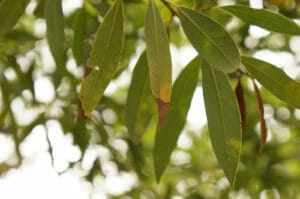 Sudden Oak Death (SOD) is a serious disease that often necessitates tree removal. It is caused by the plant pathogen Phtophthora Ramorum. SOD spreads by air and water; its most common transmission method is to splash onto other plants via rainwater. Since the mid 1990s, SOD has killed millions of trees in Oregon and California. It was first found in Oregon nurseries in 2003. OPB reports, “If Sudden Oak Death goes unchecked, it could cause significant damage to Oregon’s forest ecosystems.” Sudden Oak Death is worthy of its name; it can kill a tanoak in a few days. However, this plant pest affects more than just oak trees; rhododendron, evergreen huckleberry, azaleas, red oaks, and 130 other beloved Oregon plants are susceptible to SOD. To protect your plants from this deadly disease, read on.
Sudden Oak Death (SOD) is a serious disease that often necessitates tree removal. It is caused by the plant pathogen Phtophthora Ramorum. SOD spreads by air and water; its most common transmission method is to splash onto other plants via rainwater. Since the mid 1990s, SOD has killed millions of trees in Oregon and California. It was first found in Oregon nurseries in 2003. OPB reports, “If Sudden Oak Death goes unchecked, it could cause significant damage to Oregon’s forest ecosystems.” Sudden Oak Death is worthy of its name; it can kill a tanoak in a few days. However, this plant pest affects more than just oak trees; rhododendron, evergreen huckleberry, azaleas, red oaks, and 130 other beloved Oregon plants are susceptible to SOD. To protect your plants from this deadly disease, read on.
Sudden Oak Death: Protecting your Garden from the Ravages of Phtophthora Ramorum
Signs of SOD Infection. Phytophthora Ramorum manifests in two different ways, depending on the host plant. In shrubs and other non-woody plants, the disease shows as leaf spots, and sometimes shoot dieback. In tanoaks and oaks, the same pathogen causes a completely different symptom: bole or trunk cankers, with dark thick sap seeping from bark.
Keep in mind that other organisms and injuries can cause similar symptoms as SOD. To ensure accurate Portland tree care, it may be necessary to have a tissue sample from the tree tested at a laboratory, and to consult with Portland Certified Arborists who can identify what Phytophthora Ramorum looks like in various plant species.
Protecting your trees from SOD
A knowledgeable and watchful public is key to Oregon tree care, This vital prevention strategy can slow or stop the spread of Sudden Oak Disease. If you have identified that you live in an area affected by SOD, or have trees or shrubs that are susceptible to SOD, one way of prevention is to take many samples from many trees annually.
If you are coming and going from an area that is infected with SOD, make sure clean shoes, vehicles, pets, etc. before returning to the uninfected area.
An April 2015 OPB report on SOD similarly recommends the following prevention strategies:
- Determine if you have any susceptible species.
- Check to see if you are in a currently infected area (although, even if you are not your trees and plants can still be susceptible).
- Inspect your trees and plants for symptoms.
Sudden Oak Death is serious business. Once called the “Ebola of the plant world” by Ross Meentemeyer, director of the Center for Geospatial Analytics, SOD has the potential to devastate and wipe out the beauty of Portland’s tree-line streets, parks, and backyard gardens. It is important to prevent SOD (and ensuing Portland tree removal) when possible. Proper diagnosis and treatment and certified Portland tree care experts can help you identify, treat, and prevent the spread of this nasty tree virus. If you think that your tree may have become infected, or have other SOD related questions, it is paramount that you get in touch with Urban Forest Professionals immediately! Only you can prevent the spread of Sudden Oak Death.